 |
|
|
Home | Boating | Fishing | Diving | Water Sports | Boating Safety | Environment | Weather | Photo Blog | Add Your Company to the Directory |
| You Are Here > Home > Boating Safety > Waterway Markers |
 Waterway
Markers Waterway
Markers
Regulatory Markers
SLOW SPEED / MINIMUM WAKE requires that all vessels be completely off plane and fully settled into the water. The vessel may then proceed at a speed which is reasonable and prudent under the existing circumstances. The purpose of this restriction is to regulate vessel speed, not the size of a vessel's wake.
How do I
know if I am traveling at Idle Speed / No Wake? Vessel Wake is the movement of waves created by the motion of the
vessel. It is the track or path that the vessel leaves behind it.
Idle Speed / No Wake is the most restrictive vessel speed. This
restriction prohibits the operation of vessels at any speed greater than
that speed which is necessary to maintain steerage. An example of idle
speed / no wake would be a car with an automatic transmission that is
placed in "drive" but is given neither gas nor brake; the engine will
"idle" and the car will creep forward at a very low speed. Idle Speed / No Wake will vary from one
vessel to another depending on the particular vessel's size, shape,
power system, and steering configuration. It will also vary for any
given vessel depending on that vessel's load, the wind direction and
speed, and the sea conditions. Generally, however, it will be between 1
and 3 miles per hour for outboard and inboard/outdrive type vessels, and
between 2 and 5 miles per hour for fixed shaft/rudder vessels.
Idle Speed / No Wake is usually reserved for areas with a high risk of
collision and specific locations with high probability of damage or
injury from vessel wake. These areas include but are not limited to
blind intersections, bridge fender systems, boat ramps, and fueling
facilities. |
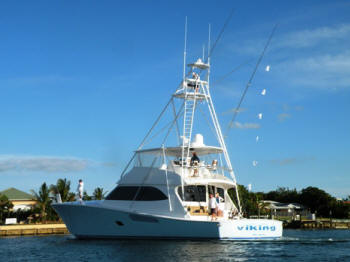 Definitions Green Buoy - marks the left (port) side of a channel when entering from seaward, and must be passed by keeping the buoy on the left side. Red Buoy - marks the right (starboard) side of a channel, when entering from seaward, and must be passed by keeping the buoy on the right side. Port Side - Left side of vessel when coming from seaward. Colors, numbers, lights and reflectors shall be as follows: Color: Green; Number(s): odd; Lights: Flashing green; Reflector(s): Green. Starboard Side - Right side of vessel when coming from seaward (red, right, returning). Colors, numbers, lights and reflectors shall be as follows: Color: Red; Number(s): Even; Lights: Flashing Red; Reflector(s): Red. Buoy Shapes - (from seaward) Port buoys will be a rectangle green marker or a can type buoy. Starboard buoys will be a triangle red marker or can type buoy.
Speed
Definitions Slow Speed, Minimum Wake - A vessel that is operating at slow speed is completely off plane, has settled into the water and is proceeding without wake or with minimum wake. Slow speed also means no speed greater than that which is reasonable and prudent to avoid either intentional or negligently annoying, molesting, harassing, disturbing, colliding with, injuring or harming manatees and which comport with the duty of all persons to use due care under the circumstances. 25 MPH Maximum Speed - A vessel that is operating at a maximum speed of 25 mph and is not operating at an unsafe speed for the specific waterway conditions, does not have an elevated bow which restricts visibility and is not producing an excessive wake which unreasonably or unnecessarily endangers other vessels or natural resources of the state.
How do I know if I am traveling at Slow Speed Minimum Wake? |
||||||||
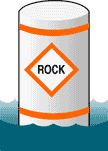 A
vertical diamond shape of international orange with white center
indicates DANGER. The type of danger will be indicated by words or well
known abbreviations in block letters inside the diamond shape.
A
vertical diamond shape of international orange with white center
indicates DANGER. The type of danger will be indicated by words or well
known abbreviations in block letters inside the diamond shape.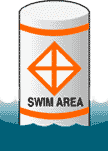 A
vertical diamond shape of international orange with a cross of the same
color within it against a whiter center without qualifying explanation
shall indicate a zone from which all vessels are excluded. An
explanation may be placed outside of the crossed area.
A
vertical diamond shape of international orange with a cross of the same
color within it against a whiter center without qualifying explanation
shall indicate a zone from which all vessels are excluded. An
explanation may be placed outside of the crossed area.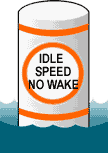 A
circle of international orange with a white center will indicate a
control or restriction. The type of the control or restriction will be
indicated by words or numerals. Well know abbreviations may be inside
the circle.
A
circle of international orange with a white center will indicate a
control or restriction. The type of the control or restriction will be
indicated by words or numerals. Well know abbreviations may be inside
the circle.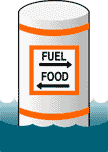 A
rectangle or square shape of international orange with a white center
will indicate information such as direction, distances and locations.
The message shall be presented within a rectangle in black letters.
A
rectangle or square shape of international orange with a white center
will indicate information such as direction, distances and locations.
The message shall be presented within a rectangle in black letters.